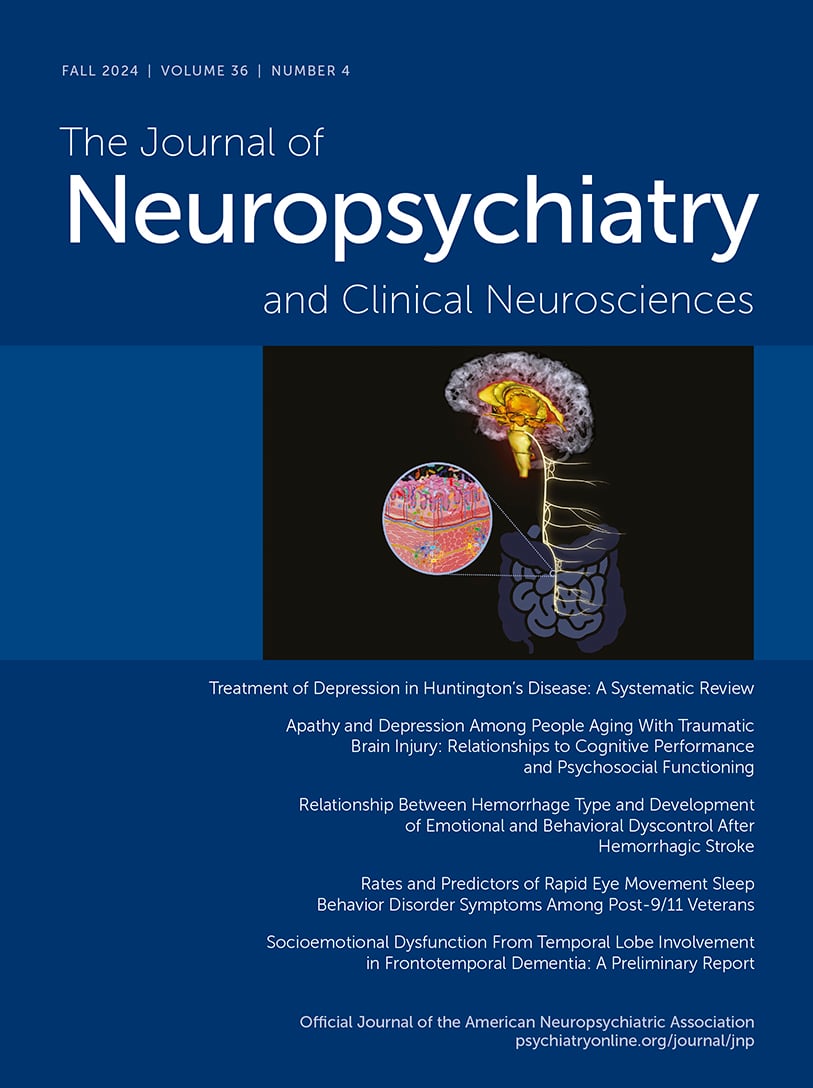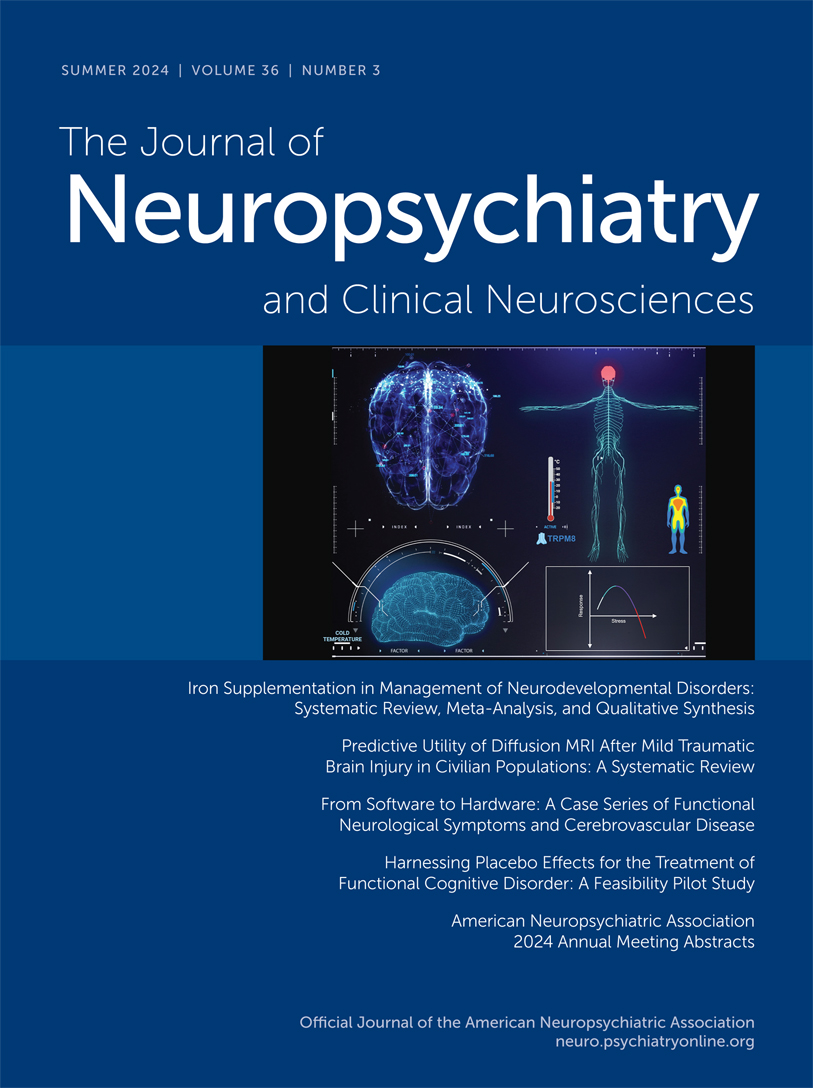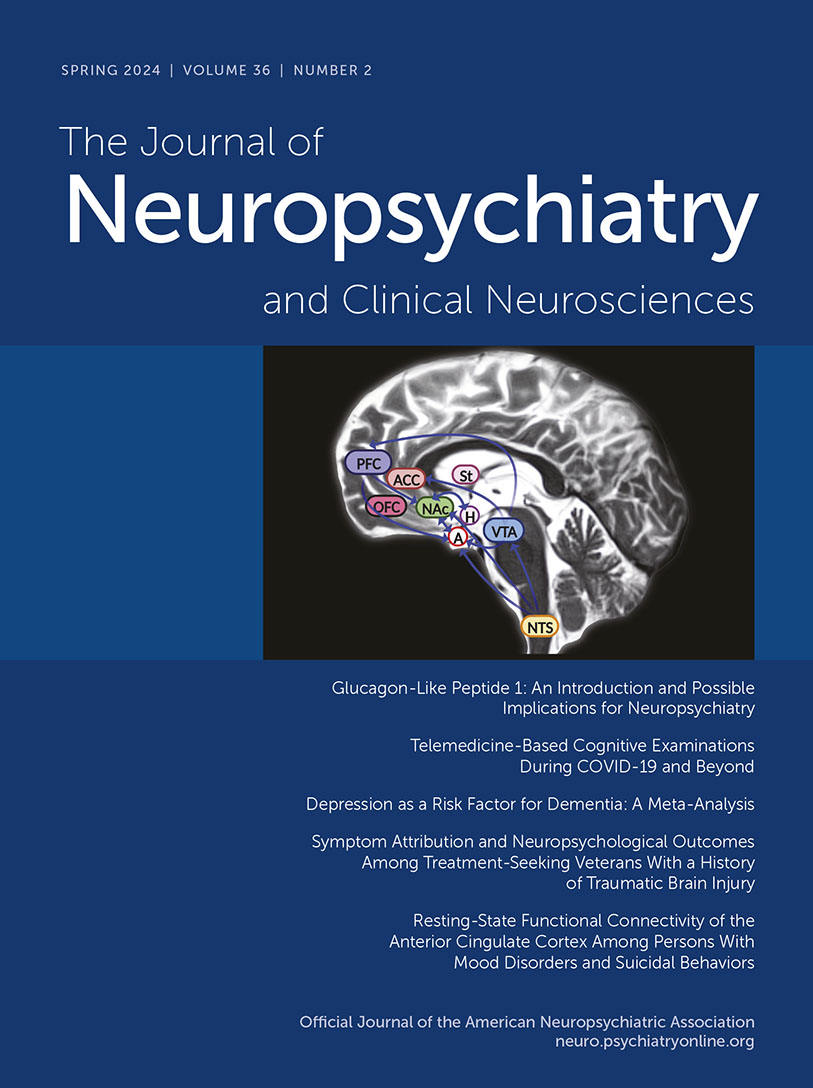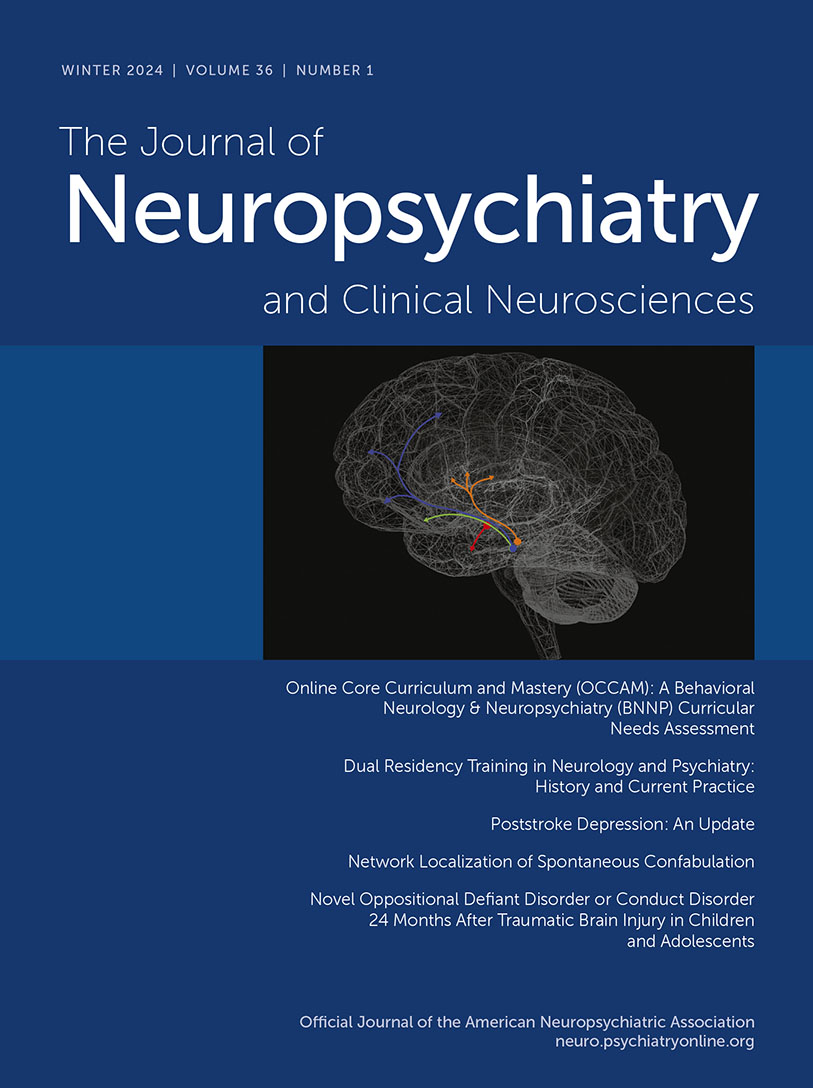The Journal of Neuropsychiatry and Clinical Neurosciences
- Volume 26
- Number 1
- January 2014
Letters
Windows to the Brain
Publication date: 01 January 2014
Pagesiv–4A better understanding of volume transmission is important in neuropsychiatry, as this is now believed to be a major mode of action for many neuroactive substances, including the modulatory neurotransmitters and many psychiatric medications.
https://doi.org/10.1176/appi.neuropsych.13110351Special Articles
Publication date: 01 January 2014
Pages5–23This systematic literature review identified important risk factors for psychosis secondary to temporal lobe epilepsy, including early age at epilepsy onset, history of status epilepticus, hippocampal sclerosis, and left-hemisphere abnormalities. ...
https://doi.org/10.1176/appi.neuropsych.12120403Publication date: 01 January 2014
Pages24–33Military combat is a common trauma experience associated with posttraumatic stress disorder (PTSD). Trauma-related nightmares are a hallmark symptom of PTSD.
https://doi.org/10.1176/appi.neuropsych.13010006Regular Articles
Publication date: 01 January 2014
Pages34–43The author retrieved 10 functional magnetic resonance imaging studies about visual tasks for emotional faces in subjects with depression. The activation foci were then summarized and entered into a coordinate-based meta-analysis.
https://doi.org/10.1176/appi.neuropsych.12060143Publication date: 01 January 2014
Pages44–50Sports involving repeated head trauma are associated with risk of neurodegenerative disorders such as chronic traumatic encephalopathy (CTE). Among the behavioral manifestations of CTE is increased impulsiveness.
https://doi.org/10.1176/appi.neuropsych.12070185Publication date: 01 January 2014
Pages51–56Brain single-photon emission computed tomography (SPECT) scans indirectly show functional activity via measurement of regional cerebral blood flow. Thirty patients at a community-based psychiatric clinic underwent brain SPECT scans. Changes in scoring of ...
https://doi.org/10.1176/appi.neuropsych.12100238Publication date: 01 January 2014
Pages57–63The authors describe neuropsychological outcomes in people with Parkinson’s disease after their participation in an NIH-sponsored, randomized controlled trial of cognitive-behavioral treatment for depression. Improvements in mood were associated with ...
https://doi.org/10.1176/appi.neuropsych.12120381Publication date: 01 January 2014
Pages64–72Frequent aggression toward others and repetitive self-injurious behaviors (SIB) can be features of catatonia in patients with autism. Similar to catatonia secondary to other etiologies, catatonia associated with autism responds well to treatment with ...
https://doi.org/10.1176/appi.neuropsych.12110284Publication date: 01 January 2014
Pages73–80The authors sought to evaluate the incidence and correlates of anxiety in early-onset Alzheimer’s disease (EOAD) versus the more typical late-onset AD (LOAD). A group of 23 EOAD and 22 LOAD patients were compared by the Neuropsychiatric Inventory Anxiety ...
https://doi.org/10.1176/appi.neuropsych.12100240Publication date: 01 January 2014
Pages81–86A few patients with obsessive-compulsive disorder (OCD) remain severely impaired despite exhausting best-practice treatments. For them, neurosurgery (stereotactic ablation or deep brain stimulation) might be considered. The authors investigated the ...
https://doi.org/10.1176/appi.neuropsych.12090226Clinical and Research Reports
Publication date: 01 January 2014
Pages87–91Restless legs syndrome (RLS) is a common neurological sensory-motor condition. High prevalence of comorbid depression and anxiety has been reported, but the few available data on the impact of RLS on cognition have been conflicting. The authors compared ...
https://doi.org/10.1176/appi.neuropsych.12120394Clinical And Research Reports
Publication date: 01 January 2014
Pages92–96Echothymia is stimulus-bound affective behavior, an echophenomenon in the domain of affect. Like echolalia and echopraxia, it is a concomitant of the environmental dependency associated with dysfunction of the frontal–striatal systems that mediate so-...
https://doi.org/10.1176/appi.neuropsych.13020020Clinical and Research Reports
Publication date: 01 January 2014
Pages97–100Epilepsy is a brain disorder characterized by recurrent and unpredictable seizures. It is associated with an increased risk of developing mental disorders. Electroencephalography (EEG) is the most important diagnostic tool for this disease; however, a ...
https://doi.org/10.1176/appi.neuropsych.13040081Publication date: 01 January 2014
Pages101–104Proton magnetic resonance spectroscopy is used to measure several metabolites in cortical gray and white matter in patients with Huntington’s disease. The preliminary results show that CAG-repeat length correlates with white-matter N-acetylaspartate ...
https://doi.org/10.1176/appi.neuropsych.13020040Past Issues
View Issues Archive
Vol. 36 | No. 4

Vol. 36 | No. 3

Vol. 36 | No. 2
